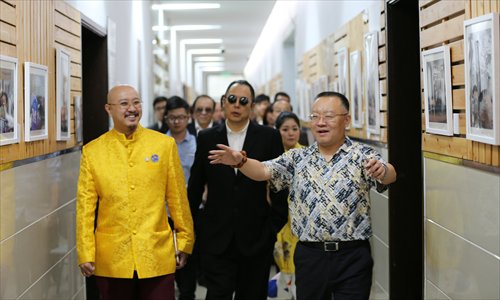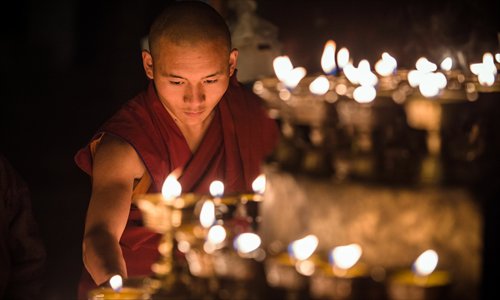Bogus Buddhas profit from Tibetan spirituality fad
A video of famous actor Zhang Tielin being "ordained" by a Tibetan Living Buddha, or Rinpoche, in an exhibition center in Hong Kong recently went viral on the Internet. It was soon revealed that not only is the so-called Rinpoche actually a fraud, but also that he's been accused of using his fake identity to attract celebrities and other followers and to enrich himself.

Self-proclaimed Living Buddha Wu Darong (left) and actor Zhang Tielin( center) appear at an event in Shanghai, November 2. Photo: CFP
Zhang Tielin, 58, an actor famous for playing historical emperors on Chinese television screens, knelt down and performed three deep kowtows, showing his allegiance to the man in front of him.
This is not another episode of a Chinese television drama, but an "ordainment" ceremony in Hong Kong held last month that was attended by around 1,000 people. In a speech at the ceremony, Zhang introduced himself as Baima Tielin, a Tibetan Buddhist name, and said earnestly in his baritone voice, "Before I became a disciple of the Living Buddha, I had a big ego, a great one. I played more than 50 Chinese emperors, and I felt I was greater than heaven."
"But since I met him and became his disciple, I felt the sky and earth became much greater, and the Living Buddha is so great, that I feel dwarfed. My life is now filled with hope," he said.
The master whom Zhang kowtowed to was the self-proclaimed Tulku Baima Aose Rinpoche, a chubby, bareheaded man with a mustache, wearing a pair of wire-rimmed glasses and dressed in a golden and crimson Tibetan robe covered with gaudy embroidery. A Rinpoche, also called a "Living Buddha" in Tibetan Buddhism, is believed to be a reincarnation of a Buddha. After Zhang performed the kowtows, the Living Buddha, sitting on a wooden throne, presented Zhang with a crown-like hat and awarded him the name "Baima Qupei," which means "the spreading of Buddhism."
It was the Rinpoche's 39th birthday, and the Hong Kong Convention and Exhibition Center (HKCEC) was filled with 100 banquet tables, most of which were occupied by the Rinpoche's followers, according to a video that later circulated on the Internet entitled "The ordainment of Zhang Tielin." Guests at the event also included Hong Kong political elites and celebrities.
Despite the pomp and circumstance, even someone unfamiliar with Tibetan Buddhism could sense there was something off about the ceremony. The supposedly religious event wasn't held in a temple, but in a venue for pop concerts and trade fairs. The setting looked more like a business banquet than something spiritual. The most dubious element was Zhang Tielin, whose public image - the actor has been involved in scandals with ex-lovers and illegitimate children - was incongruous with such an ordainment.

A Tibetan lama lights up lamps in the Ramoche Monastery in Lhasa, Tibet Autonomous Region, December 5. Photo: CFP
The fake Rinpoche
The video of the ceremony went viral after it was uploaded to the Internet in late November. When journalists showed it to Tibetan lamas and authentic Rinpoches, many were amused and said that the Rinpoche to which Zhang had pledged his loyalty is a fake.
Lin Cong, student of the prestigious Khejok Rinpoche, said on Weibo, a microblogging site, that Zhang's prostration was a combination of Indian yoga's sun salutation postures, the genuflection of European royal courts, and prostration in the tradition of Chinese Buddhism. His outfits also weren't correct - he was wearing white and purple robes, colors which shouldn't appear on the same person, Duoshi Rinpoche, a venerable monk, told China Newsweek.
The Baima Aose's outfit was more controversial, as it resembled an emperor's dragon robe. And while Baima Aose says he is a member of the Nyingma school, one of the four major schools of Tibetan Buddhism, the hat which he gave Zhang Tielin resembled those worn by acolytes of the Sakya school. "How can he be a follower of this school?" Duoshi Rinpoche said.
The incident soon grabbed attention as it highlights the issue of fake Living Buddhas in China that have become more common in recent years as Tibetan Buddhism becomes increasingly popular - especially among celebrities, businessmen and politicians.
While it was Zhang who stirred up public attention, netizens' interest soon shifted onto the mysterious Living Buddha and his identity. According to a Hong Kong media outlet's interview with Baima Aose in 2000, he said he is an ethnic Han born in Quanzhou, East China's Fujian Province in 1976 with the name Wu Darong. At age 8, he moved to Hong Kong with his parents and worked at a Japanese department store, and got married in 2000.
Although his mother was a Christian, he said that what brought him to religion was a cassette of The Great Compassion Mantra, a classic Buddhist mantra. He listened to the mantra over and over again and felt driven by what he called a magical spirit which he couldn't explain.
According to Wu's account, he visited Mount Wutai in 1997 and acknowledged prestigious masters Jidu and Haixin as his teachers, and received teachings in the Karma Kagyu lineage. He then visited many prestigious monks and received teaching from the Nyingma Buddhist school. In July 2007, when Baima Luozhou Rinpoche took Wu to Qinghai Province's Chalang temple, Dabiding Rinpoche, a distinguished Rinpoche there, recognized that Wu was the reincarnation of his niece. He was then ordained and officially started his life as a Living Buddha.
The making of a Rinpoche
The true story is quite different according to investigations conducted by The Beijing News and China Newsweek. They claim that Wu worked as a street vendor and a feng shui master in his early years, and later started to sell Buddha statues.
His life changed after meeting Chuang Shih-ping, a famous and well-connected Hong Kong entrepreneur and founder of the Nanyang Commercial Bank. Chuang then was a member of the standing committee of the Chinese People's Political Consultative Conference, an official political advisory body, and a patriotic businessman. When he met him, Chuang was in his late 80s. Wu sold a wooden statue of Bodhisattva to Chuang and somehow gained the old man's trust.
In 2002, Chuang and Wu co-established the Hong Kong Buddhist Culture Estate (HKBCE), which was registered as a company but presents itself as a charity. Chuang, who was over 90 years old then and rarely appeared in public, visited many government officials with Wu to promote his latest cause and donated money to them. This explains why Wu often appears in group photos with officials from China's religious administration authorities.
An official from the State Administration of Religious Affairs told tibet.cn, a State-owned Tibetan news site, that many officials met with Wu back in 2006, but back then his identity was the vice president of the HKBCE, not a Living Buddha.
In 2007, Chuang died at the age of 97. In the same year, Wu was "ordained" in Qinghai, according to HKBCE materials.
No records
When China Newsweek phoned Qinghai's Golog Tibetan Autonomous Prefecture, home to Chalang Temple where Wu claims he was first ordained, authorities there say that they are still investigating matters. "I've never heard of this guy, nor have we issued a Rinpoche certificate to him," a local religious administration official told China Newsweek.
Wu's promotional material claims that he has been ordained in as many as 25 temples in Qinghai and has over 600,000 followers. This was also denied by the religious authorities of Jianzha County, Huangnan Prefecture, home to the Aqiong Nanzong Temple, one of the 25 temples listed. If Wu was ordained there, they would have reported it to local religious authorities, but the authorities said that "Baima Aose Rinpoche was never ordained in Aqiong Nanzong Temple."
Wu also claims to posses an ordainment letter from Katuo Monastery in Sichuan province's Garze Tibetan Autonomous Prefecture.
But the monastery said the letter was merely a certificate proving Wu donated to a Buddhist ceremony held by the monastery. Wu altered the contents of the letter in the Tibetan language to make people believe the letter certified his status as a Living Buddha.
The investigations appear to show that Wu's Buddhist persona is a cover for his business ambitions.
In 2013, the World Trade United Foundation Company held an inaugural ceremony in Los Angeles. This is another company owned by Wu that's disguised as a charity, and three of the 10 board members of the company are Wu, his wife and his father. Other honorary company presidents include Zhang Tielin, Hong Kong entertainer Eric Tseng and other celebrities.
According to the company's records, it is promoting a project called the Global Holy Spring Program. It claims to be able to extract water from the air through an "air dew conversion machine" and produce fresh water. According to Hong Kong's company registry office, the Holy Spring Dingfeng Smart Technology company was established in August, one of the board members being Wu's wife. The company also produces smart watches and smartphones.
Wu is not the only man who's attracting followers through his relationship with celebrities. Li Yi, a Taoist priest famous for his questionable health programs, and Wang Lin, a self-proclaimed qigong master who is being investigated for murder, both attracted many celebrity followers and thus gained money and fame.
To help followers of Tibetan Buddhism distinguish between real Rinpoches and fake ones, Zhu Weiqun, chairman of the Chinese People's Political Consultative Conference's Ethnic and Religious Affairs Committee, told China Central Television that the authorities are setting up a database of legitimate Rinpoches in China and will publish the information online.
He added that some fake Living Buddhas pose threat to national security, as they use the money they collect to sponsor illegal or even separatist activities in the Tibet Autonomous Region.
Wu didn't respond to interview requests by the media, but published several statements on his Weibo page.
In his latest statement, the fake Rinpoche, now using his real name Wu Darong, apologized for the incident and said he will no longer be the mentor of his disciples.
But followers still worshipped him, disregarding media exposes. "I prostrate myself before you," a follower said on the comment section of Wu's latest Weibo.
Global Times - Agencies
Newspaper headline: Reincarnation rip-off